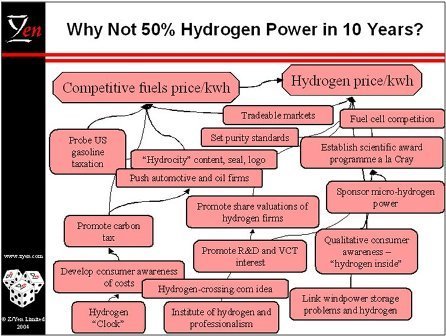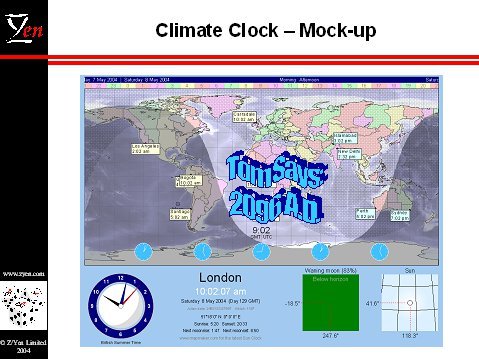The Climate Clock
Background
This idea originated in 2004 in response to a desire to contrast views on climate change.
E3G (www.e3g.org) and others, including Z/Yen Limited (www.zyen.com), are asking, “why can’t we have renewable hydrogen power in X years?” It’s a great question in that, subject to choosing X, all negative answers spell disaster. Without moving almost wholly to renewable hydrogen power, significant climate change is unavoidable. While this view is increasingly accepted among scientists and engineers, again with a great debate about what value they might give X, it is not a view that influences the public and thus in turn politicians, senior business people or senior government officials. To set out one target, moving to 50% hydrogen power in 10 years, leads to an ambitious web of projects that might be needed to get there quickly:

However, there is little consensus about timeframes, so first we need to bring the immediacy of the climate change problem to the attention of a much wider audience. With consensus about the immediacy, we can move to galvanising people around solutions. Solutions will be manifold – 6 billion people will need to make slightly different decisions every day about power supplies, purchases, transportation, insulation, planning changes from petrol/gas stations to hydrogen stations, the social status of being an early user of a hydrogen car, the re-design of national grids, taxing non-renewable fuels or how much effort to put into less permanent solutions. The first step is to make people aware of the inevitability of the problem.
The Climate Clock
Our proposal is to bring the immediacy and inevitability to the attention of the public through a “clock”. To personalise it, and to give credit to the initiator of the idea, it might be called “Tom’s Clock” – Tom Burke, currently Rio Tinto’s environmental advisor and a former director of Friends of the Earth. Naturally, in today’s age, The Climate Clock will definitely have a virtual form, i.e. a ubiquitous computer application suitable as a screensaver, but might also take physical forms. For instance, a Mauna Loa physical clock might feed raw CO2 numbers, or a Maldives physical clock might set sea level. It might look like a modified Sun Clock:

Key features are that the Climate Clock:
- can be re-set to show different years and the likely state of the planet in that year, e.g. water areas, barren land, ice cover and fertile land (i.e. think a changing environmental map rather than the static political outline map above);
- will have tabs allowing people to display CO2, or water levels or temperature;
- can be set in a ‘countdown’ mode, e.g. days till we hit 400ppm of CO2 or counting up to, say 400ppm, in rapidly-running increments;
- a screen can be emailed to anyone – email a friend in London showing that SE England in 2056 is 50% underwater;
- the Climate Clock and information about the Climate Clock can be updated from a central website with the intention of building a community of interested users around the website.
However, it is much more than a clock, it should also start a movement by inspiring others to create their own Climate Clocks and for wider groups to be interested in the popularity of different types of Climate Clocks. Who might make their own clock?
- scientists with alternative views of the time to catastrophic change;
- organisations promoting a new time based on planned actions, e.g.:
- an automotive or energy company promises to move more to hydrogen and publishes a clock with a new date, e.g. 2120 instead of 2096 above;
- a product company, e.g. an insulation firm, claims that each use or purchase of their product adds 6 seconds to the clock and wants to ‘prove’ it publicly;
- an environmental group claiming that their “hydrocity” index usage will push the date further out, e.g. 2125 instead of 2096 above, or that each airmile subtracts 0.14 seconds from the clock;
- political activists claiming that some action, e.g. Kyoto being ignored, is bringing the date forward, e.g. 2050 instead of 2096 above.
- users focused on their regions, e.g. a Maldives version or a Greenland Ice Cap version with a much nearer date, or users focused on particular species, e.g. extinction of X.
The website for the clock might run as an online “game” or scoreboard showing the popularity of various clocks, the numbers of downloads or the numbers of accesses, with discussion groups objecting to particular elements of certain clocks, e.g. claims made about emission reductions, or debating the wide divergences among certain clocks.
How Does It Tick? – The Mechanics
The Climate Clock would sit on top of a simple system dynamics software tool. Interested users, albeit a minority – but a crucial one, could access the system dynamics tool directly and alter variables to see what might turn back the clock. With the ‘back’ of the Climate Clock ‘off’, a section of the ‘clockwork mechanism’ might look like the following:

Interested users can change key variables and see the consequences. If they feel strongly enough about alternative ideas, they can change the base model to suit their thoughts, upload their model and publish it on the website, e.g. “Shell’s Clock with New Hydrofuel”. In addition, the clock could easily take ‘speaking clock’ form using automated voice response technology.
Summary
In short the Climate Clock should:
- provide a tool to bring the immediacy of climate change to the attention of the widest community at a low cost;
- create news about climate change and hydrogen in its own right, e.g. “following today’s announcement of a major EU R&D programme, the Climate Clock pushed back climate catastrophe by 27 months”;
- develop consensus about dates, thus leading to more coordinated priorities, e.g. a mini-Copenhagen Consensus project about climate change alone;
- stimulate debate about alternative ideas and solutions to climate catastrophe;
- help to identify a community which can be used to move forward towards solutions.
Next Steps
This document is designed to initiate conversation. Z/Yen is interested in exploring these issues further with all parties. Please contact Michael Mainelli, Director, Z/Yen Group Limited, michael_mainelli@zyen.com